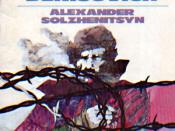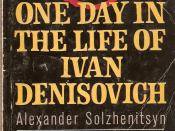In "One Day in the Life of Ivan Denisovich," Alexander Solzhenitsyn clearly develops Ivan's character and his submission to the ten-year sentence that he faces. In an excerpt describing the zeks work preparation, Solzhenitsyn uses diction, detail, and point of view to develop Ivan's attitude of forced acceptance.
Throughout the excerpt Solzhenitsyn uses diction to further illustrate Ivan's perception of his surroundings. Solzhenitsyn first describes the "deserted area" as "red" and "hazy." This description constructs a setting that is both invading and impersonal. As the paragraph develops Solzhenitsyn depicts the authorities as threatening. This distinctly portrays the forceful nature of the authorities and subjugation of the zeks. This aspect is also mimicked in the rest of the excerpt as well as the novel. Prior to the zeks daily work they attempt to find warmth in the cold, deserted steppe. In describing this particular time, the author expresses that the zeks will have plenty of time to "sweat blood."
This simple statement defines the basic severity of the zek's daily life. Accompanying this statement, is the both the zek's sense of dread as well as the acceptance of this horrible inevitability. Continuing, Solzhenitsyn describes the room the 104th were to work in, as "even" having a thermometer. This emphasis on the word "even", further erects the sense degradation of the oppressive institution as well as the effects it has had on the mindset of its inhabitants. The apparent astonishment of the main character in the presence of a thermometer also shows the extremity of his daily surroundings. Solzhenitsyn again develops the attitude of Ivan in his description of passing of time. Even before work has begun, the time is portrayed as dragging. This statement shows the undesirability of the task as well as the inescapable acceptance it induces.
Solzhenitsyn's constant use of detail also serves to further this attitude. The author uses detail in describing the method for acquiring warmth. This expresses the importance of getting warm, and therefore the overall acceptance of their cold and impersonal surroundings. Emotional warmth, being almost scarcer than physical warmth, is forgotten as Ivan is forced to accept the reality of the situation. Later in the excerpt the author describes Ivan in his rest. Here, Solzhenitsyn uses detail when he describes Ivan "feeling something sharp pressing against the left side of his chest, near his heart." The detailed description is important in that it creates a clear relationship between life and pain. As expressed in this account, that which keeps Ivan alive, his life and survival in the prison, also causes him great pain. Only Ivan's acceptance of these circumstances can preserve his life.
Lastly, Solzhenitsyn uses point of view to accurately portray Ivan's true attitude towards his surroundings. In this excerpt Solzhenitsyn primarily uses third person point of view. By using third person point of view, Solzhenitsyn gives more inferences to Ivan's attitude and gives greater credibility to the occurrences mentioned. Third person also provides the reader with Ivan's overall susceptive attitude expressed throughout. Also present in the excerpt is a switch from third to first person point of view. This slight change is highly significant. In the few instances that Solzhenitsyn does use first person, it serves as a sense of relief in Ivan. The example, "we'll sit here in the corner, it's not so bad," serves to demonstrate the sense of belonging and contentment that accompanies the author's first person point of view. Also in an almost first person point of view are the numerous digressions Solzhenitsyn incorporates in the excerpt. These each aid in revealing Ivan's actual thoughts concerning the surrounding that he is plagued to endure.
Solzhenitsyn masterfully uses diction, detail, and point of view to develop Ivan's attitude of forced acceptance towards his surrounding and overall situation. Ivan's susceptive attitude towards the surroundings he faces serves to reveal the harmful endurance embraced in his ten-year sentence and that one single day.



Nice essay, good points
I thought it was very good, you presented your evidence. Some spots didn't flow as well but you still got the idea. Nice work.
0 out of 0 people found this comment useful.